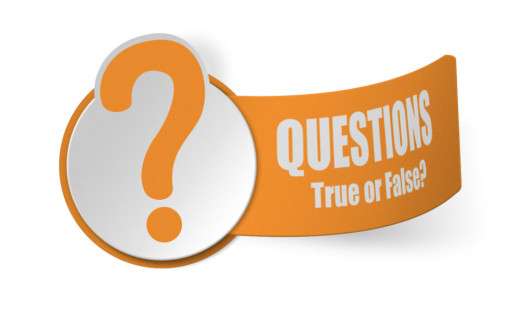True or False: Personal Finance

Using T-F Statements to Overcome Personal Financial Challenges
Reading true or false (T-F) questions can improve learning about concepts that are critical to everyday activities such as personal investing and financial management of resources. While T-F statements are rightfully judged as unreliable for assessing knowledge in a testing environment, this unique format often enhances a reader’s engagement in articles such as this one. This is especially true when the T-F answers include detailed explanations about why a statement is either true or false.
The following paragraphs illustrate the use of a true-false format to facilitate a better understanding of personal investment issues such as mortgages, consumer loans and credit reports. A detailed answer and explanation is provided for each true or false statement. For example, what is a zombie foreclosure and how can it impact a homeowner?
What makes us human, I think, is an ability to ask questions, a consequence of our sophisticated spoken language.
— Jane Goodall4 Personal Finance Topics Covered in T-F Questions Below
- Obtaining a Mortgage After Bankruptcy
- Zombie Properties and Zombie Foreclosures
- 3-1 Credit Reports
- Private Mortgage Insurance
1 — True or False?
When a mortgage is used to purchase a property, individuals must wait seven years to buy a home after filing for bankruptcy.
1. Life After Bankruptcy
The initial true or false statement encompasses a legal process (bankruptcy) that is increasingly common due to personal events such as an extended illness, injuries, unexpected medical expenses or a job loss. According to multiple estimates, about two-thirds of bankruptcies involve medical issues.
After such unexpected circumstances, life will eventually return to “normal” activities such as buying a house. How soon is that possible after a bankruptcy? While credit reports and scores will typically be negatively impacted for seven years after the bankruptcy process is completed (discharged), lenders usually impose a shorter period before considering a mortgage application. Conventional loans from traditional lenders often involve up to a four-year waiting period. However, some alternative lenders now offer non-qualified mortgages that permit a home loan 12 months after a bankruptcy discharge or other adverse real estate transaction such as a short sale or deed-in-lieu of foreclosure.
The answer to the first true-false question: false.
2 — True or False?
A zombie foreclosure refers to a foreclosure process that was started by a lender and then not completed after the homeowner has left the property.
2. Zombie Foreclosures and Properties
Foreclosures can occur for many reasons, and the 2007-2008 financial crisis (also known as the Great Recession) produced a record number of foreclosed homes. While some individuals choose to stay in their home until the foreclosure process has been finalized, it is not unusual for some homeowners to leave as soon as foreclosure proceedings start so that they can get on with their lives. However, the legal process is not always completed. Sometimes this is due to technical problems, and in other situations the lender simply stops foreclosure proceedings because the costs outweigh the benefits. In such cases, lenders are not always required to notify owners that the process has stopped, and the original owner is often unaware that a foreclosure is not moving forward. This is a prime example of a zombie foreclosure.
When this happens, the home ends up still being owned by the original owners (often without their knowledge because they are not contacted and assume the property was taken over by the lender). A home like this is frequently referred to as a zombie property. In such cases, the owner of record still has a legal obligation to pay debts such as property taxes and homeowners association dues. Credit scores are typically impaired when such debts remain unpaid. To avoid this potential problem, a homeowner should always confirm that a foreclosure sale was completed and that the property title was transferred.
On a nationwide basis, slightly less than 3 percent of foreclosed homes are currently vacant. But areas such as Washington DC, Oregon, Kansas, Montana, Maine and New Mexico have much higher rates (ranging from 6-10 percent). During the financial crisis about a decade ago, the peak number of zombie properties throughout the United States exceeded 275,000. The current estimate is less than 10,000, and two-thirds of the impacted properties are located in New York, Florida, Illinois and Ohio.
The answer to the second true-false question: true.

3 — True or False?
Lenders usually obtain a credit report and score from one consumer credit bureau.
3. Credit Reports and Credit Scores
While credit scores have their origins in the 1970s, the version known by the acronym FICO (derived from the Fair Isaac Corporation that created it) did not appear until 1989. This specialized scoring model is used by many lenders (especially for mortgage applications). All three major credit bureaus (TransUnion, Equifax and Experian) can supply a FICO-based score.
Because lenders do not always report payment histories and other data to all credit bureaus, an individual’s credit score can vary from one credit bureau to another. To overcome this challenge, it is common for lenders to obtain a 3 in 1 credit report (also called a 3-1 credit report) that includes credit history data from the three national credit bureaus.
Some credit bureaus have periodically offered “educational credit scores” that were created with the goal of educating borrowers about credit score factors. However, many consumers have been unpleasantly surprised when the credit reports pulled by lenders showed a FICO credit score that was significantly different from the educational score. Due to problematic issues such as this and other credit-related errors, the Consumer Financial Protection Bureau (CFPB) recently stated that credit reports were complained about more than any other product. The three nationwide credit bureaus were also the source of more complaints than any other companies during 2018 (more than 250,000 complaints). Perhaps unsurprisingly, all three credit bureaus have been periodically fined by the CFPB. In addition to credit report inaccuracies, it is not unusual for credit bureaus to be at the center of data breaches such as the 2017 Equifax data breach incident that effected 150 million consumers and resulted in a $650 million legal settlement.
When consumers discover errors in their credit report, it is essential to report the mistakes separately to each of the three major credit bureaus. Each company has different administrative procedures, and corrections can take months (or years) to materialize. The absence of a streamlined way to fix credit reports is a recurring problem for anyone who discovers a credit report error. Nevertheless, borrowers should be vigilant in their efforts to correct errors since negative credit reports (even when they are not accurate) can impact job searches and interest rates charged on consumer loans such as mortgages and credit cards.
The answer to the third true-false question: false.
4 — True or False?
The primary purpose of mortgage insurance paid by a mortgage borrower to a lender is to pay off the mortgage balance in the event of death or disability so that the surviving family owns their home debt-free.
4. Private Mortgage Insurance (PMI)
Mortgage insurance first appeared during the 1880s in the United States. The concept disappeared for about 25 years when the entire mortgage insurance industry was bankrupted by the Great Depression in the 1930s. Mortgage insurance emerged again in the late 1950s, and PMI continues today as a component in many mortgage payments.
While there are exceptions, borrowers who want to buy a home with a down payment of less than 20 percent are often required to buy mortgage insurance. This coverage is paid for by borrowers and is designed to protect lenders if borrowers default on their mortgage payments. The insurance “protection” is for the benefit of the lender even though the borrower pays monthly premiums.
PMI does not pay any life insurance benefits to borrowers in the event of death — the only benefit received by the borrower is the ability to purchase a home with a smaller down payment. Without mortgage insurance, many lenders would be unwilling to offer a mortgage loan unless a sizable down payment is included. For borrowers who want to provide a debt-free home to their family in the event of death, term life insurance coverage should be considered for a time period that matches the length of the mortgage.
The answer to the fourth true-false question: false.
4 Reminders Based on True or False Explanations Shown Above
|
|---|
Review Non-Traditional Mortgage Choices
|
Confirm Foreclosure Completion
|
Report Errors to 3 Credit Bureaus
|
Remember Limited PMI Benefits for Borrowers
|
Personal Debt Reduction Strategies
One More Thing: True or False for Anyone Who Enjoys Learning
A true or false approach to learning can help to dispel common misconceptions — and the willingness to question everything is a skill that will provide lifelong benefits. This was one of my major goals in using the four T-F examples shown above to illustrate personal finance concepts that can easily impact everyday lives. As observed by Albert Einstein, “The important thing is not to stop questioning.”

I never learn anything talking. I only learn things when I ask questions.
— Lou HoltzThis article is accurate and true to the best of the author’s knowledge. Content is for informational or entertainment purposes only and does not substitute for personal counsel or professional advice in business, financial, legal, or technical matters.
© 2019 Stephen Bush








